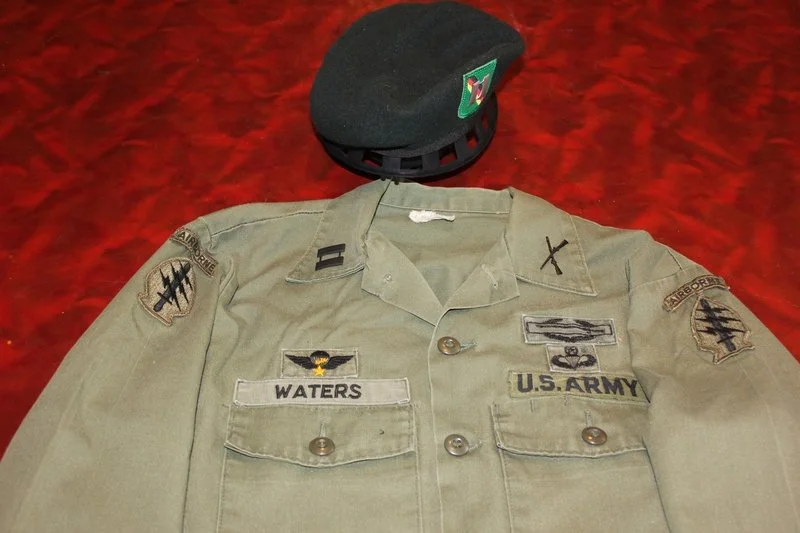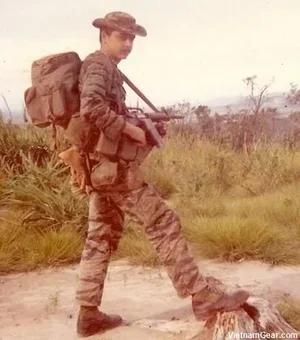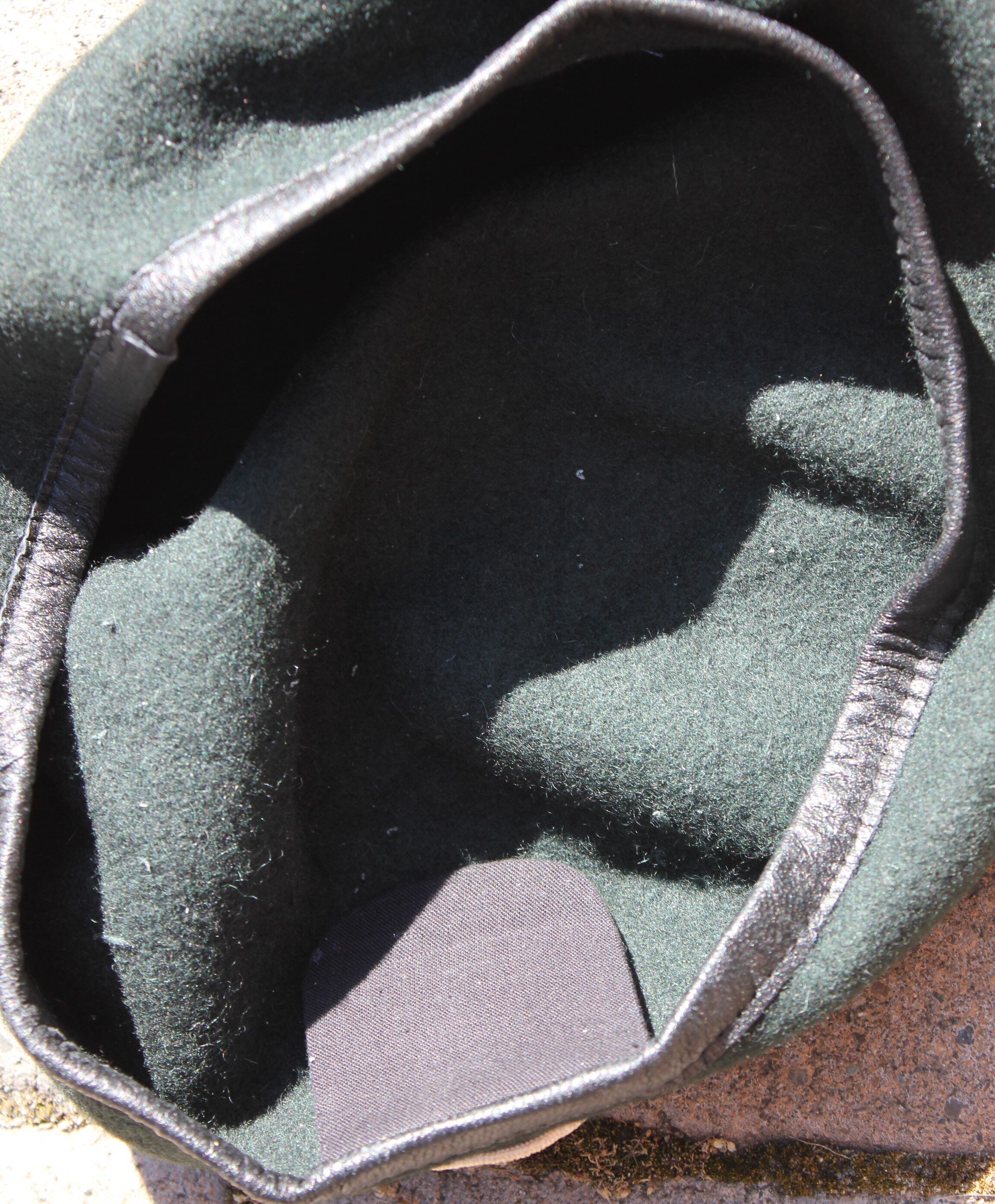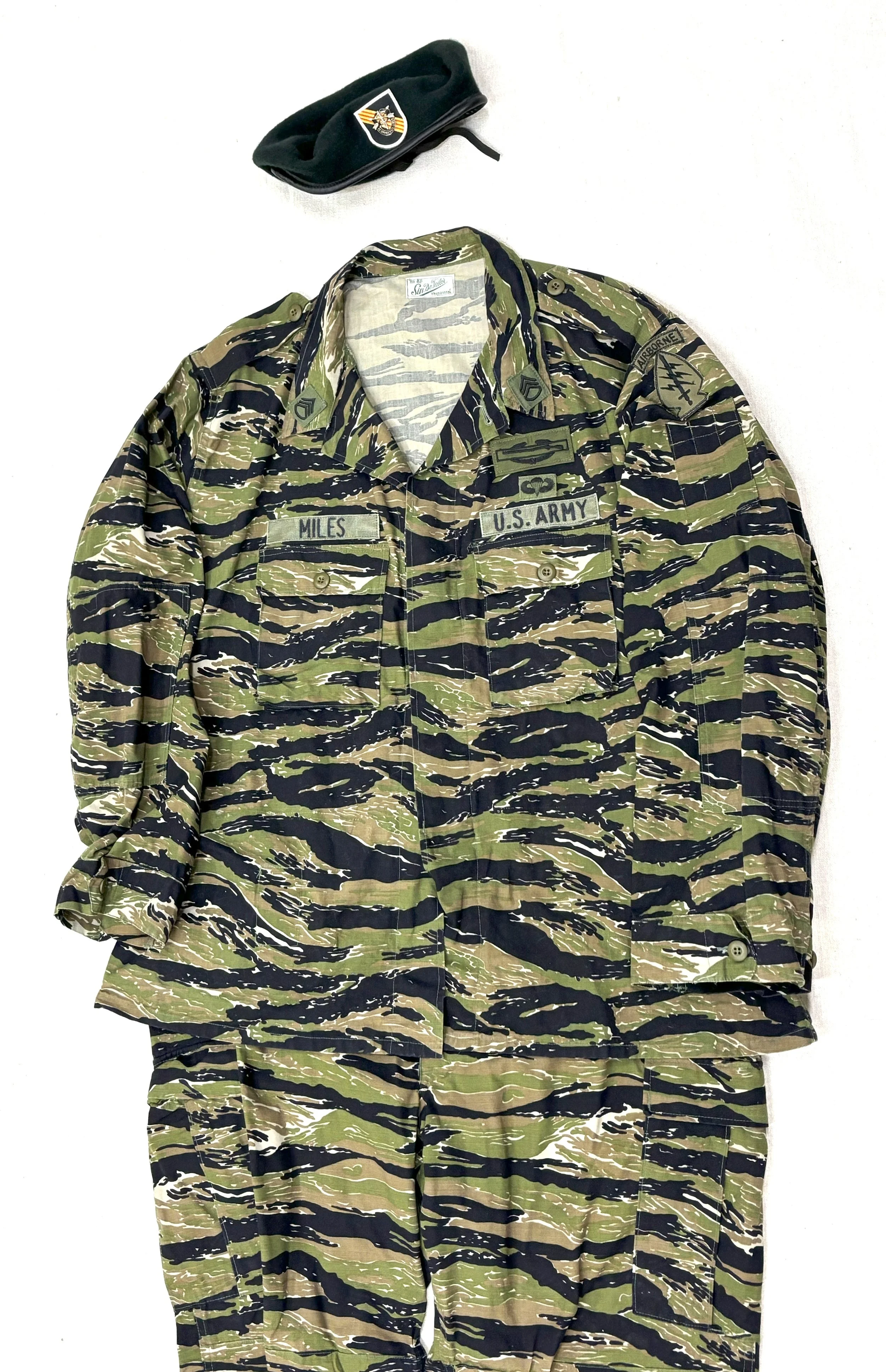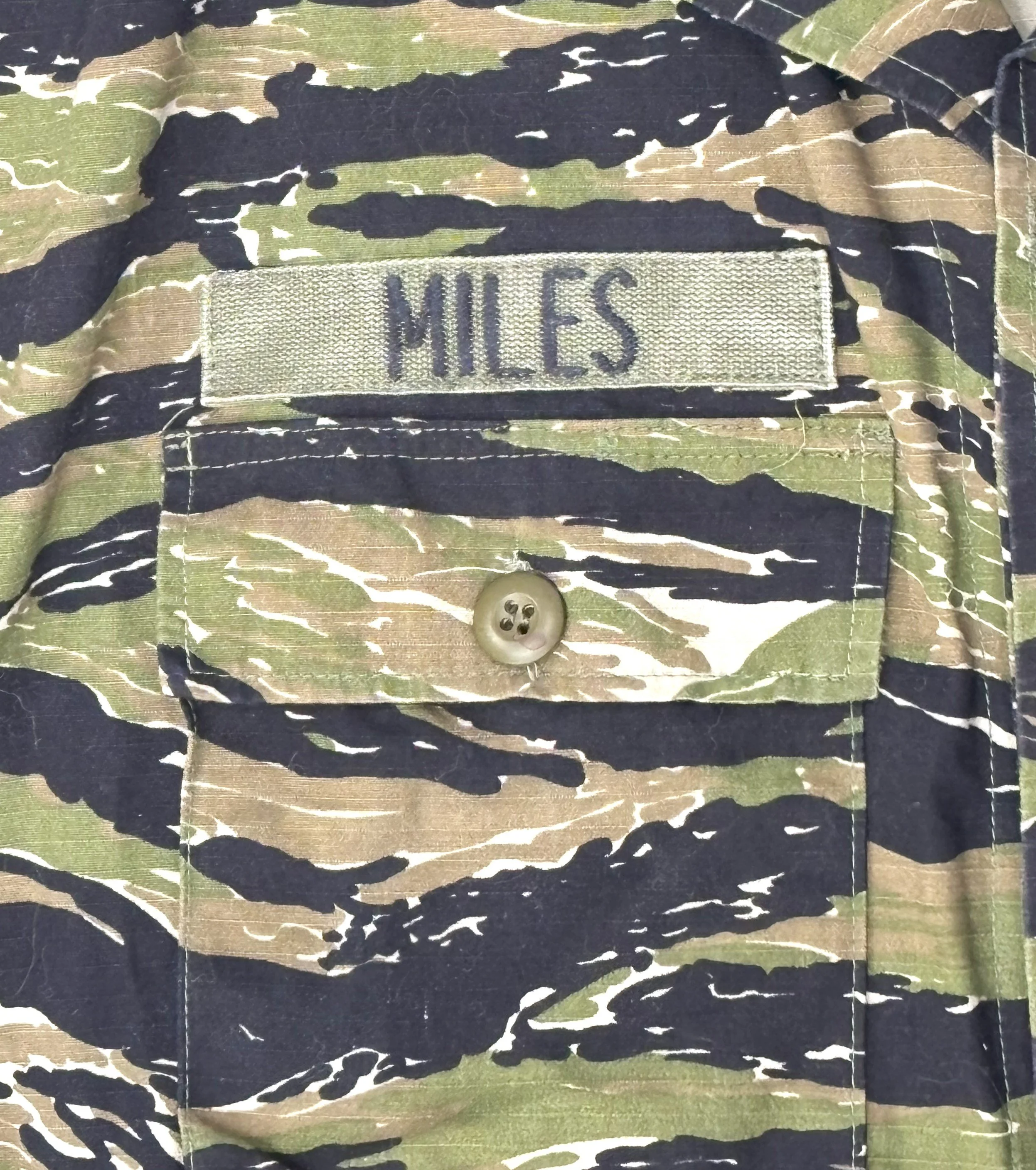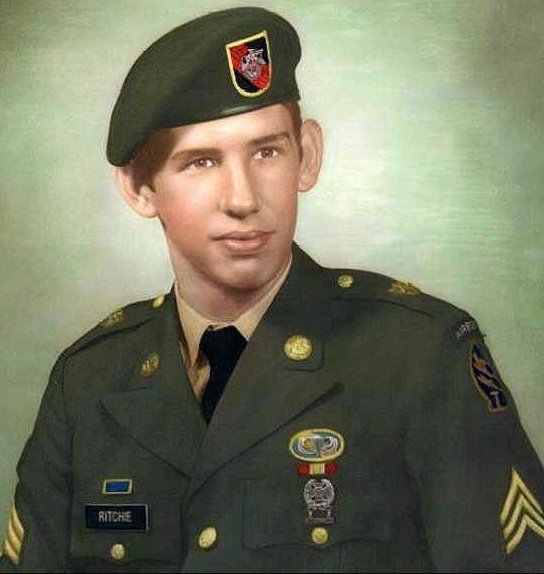U.S. Army Special Forces:
Sergeant First Class, 1st Special Forces Group (Airborne), Fort Bragg, North Carolina 1962 –1964:
Special Forces, also known as Green Berets, trace their heritage back to the Office of Strategic Services, or OSS, of World War II fame. The OSS was a para-military intelligence service that operated behind enemy lines in both the European and Pacific theaters, conducting reconnaissance, sabotage, and other clandestine activities directed against the Nazi and Imperial Japanese forces. Members of the OSS went on to serve in both the CIA and the Special Forces.
Special Forces were formally established in 1952 by the indomitable Colonel Aaron Bank, himself an OSS legend, who had parachuted into Nazi-occupied France, eventually formulating a plan to capture Hitler if he had tried to flee from Berlin. Located on Smoke Bomb Hill in Fort Bragg, North Carolina, the Special Forces began recruiting. They had their pick of the best America had to offer: battle-hardened paratroopers, former OSS men, and other veterans of World War II and the Korean War. The wearing of the distinctive green beret by Special Forces soldiers was controversial amongst Army leadership until General Yarborough cleared it up for us in 1961.
US Special Forces came into their own, proving themselves in the jungles, villages, and cities of Southeast Asia, especially in Vietnam. As the Vietnam War escalated, Special Forces soldiers carried out their primary duty as military instructors, coaching and mentoring South Vietnamese forces as they fought against the Viet Cong and North Vietnamese Army. Special Forces worked with South Vietnamese, Chinese Nhung mercenaries, and the Montagnards, some of whom were fresh out of their jungle villages. These tribal peoples turned in their loincloths for military boots and uniforms, their Green Beret mentors molding them into an effective fighting force.
Like many of the Special Forces, this Master Sergeant Mustard has served in combat before; he wears Parachutist Wings as well as the Combat Infantry Badge. He wears spit-shined Corcoran jump boots with starched fatigues as he prepares younger Green Berets for combat.
The First Special Forces Group sent teams to Vietnam for six-month-long, temporary duty tours. They were at Camp Hardy / Combat Training Center, located in the Northern Training Area of Okinawa, training the Army’s Special Forces, as well as SEALS and some Marines and the like, before their redeployment to Vietnam. The 1st Special Forces Group was activated at Fort Buckner, Okinawa, in June of 1957, but the 1st Special Forces Group holds the sad distinction of having first and last Special Forces soldiers killed in Vietnam.
“Updated” Sergeant First Class, “Berry Sadler”, 7th SF.GP. Fort Bragg, NC. 1962-64:
Berry Sadler was famous for writing the song “The Ballad of the Green Berets,” which the Green Berets adopted for their own. He wrote many “Pulp Fiction Books as well. He was born on November 1st, 1940, in the city of Calsbad, in New Mexico. spending his youth in a small town. His Mother and Father divorced in 1945, then his Father died three years later. His Mother and he then traveled around, moving from place to place in the Southwest, finally settling down in 1950 in Leadville, Colorado, as the Korean War brewed up. He would attend school there, but dropped out in the 10th Grade, in High School. So in 1958, he joined the “New” Air Force, as they were still transitioning from the U.S.Army control, and served there for 4 years, with a tour to Japan, where he decided to train in their Martial Arts, and schooled enough to get a GED, getting an honorable discharge in 1962.
He had not satisfied with the Air Force, but there was damn few decent job prospects available, so he decided to return to the military, but wanting more action, possibly more money, I guess they offered something better than he had, and so joined the Army in August of 1962, and went through the Army’s Airborne Training, and after hearing about the development of the Special Forces, he volunteerd, as a Medic. He would attend more schooling in Texas, at Fort Sam Houston, in the Brooke Army Medical Center.
Then he went to the Advanced Medical Training School at Fort Bragg, in North Carolina, in December of 1963, with times changing fast in America, he was married to 19-year-old Lavona Edelman, a Women’s Army Corps (WAC) Nurse. Life moved quickly for them, but then came the Vietnam War. It would be a life-altering event for them. He would serve there from late December 1964 to late May 1965. Just as the United States was officially entering the conflict, the French had left 1 year prior.
He served most of his tour, as sort of an advisor role, as a Medic with the 5th Special Forces Group’s Detachment A-216, located at Camp Hardy, in Pli Do Lim, in the Central Highlands of South Vietnam. There, with other Army medics, he would administer to the medical needs of the local “Hill People” known as the Montagnard Tribes, as well as Vietnamese civilians, as well as their own Special Forces personnel. They worked with these people, and earned their trust enough where they would go and search out the North Vietnamese Forces, and their Viet Cong Collaborators in reconnaissance patrols, and ambushes, even outright battle with them. On one of these patrols, he stepped into “Punji Stakes” a common Vietnamese booby trap, and his wounds got badly infected, to the point that he had to be evacuated from Vietnam, and sent for treatment in the Phillipines, and eventully home, and discharged from the Army.
Sadler moved away from the States in the 1980s to Guatemala to write books. Being medically trained, he often provided medical care for the impoverished Mayan people. But it’s said he got involved in the selling of illegal firearms, and on September 7, 1988, he was shot in the head, in the city of Guatimalla. Some witnesses and the Police said he had accidentally shot himself, but with Special Forces, even Medics have extensive training with weapons. But on the same note, others have said it was a robbery, possibly even an assassination attempt. Some of his close friends flew him to specialists in Nashville, and the VA Hospital provided extensive surgery for him. When it was over, though, he was left a quadraplegic, with severe brain damage, confined to a hospital bed, until his death on November 5, 1989, in Murfreesboro, Tennessee.
*Captain, ‘Lauri Törni’ (Thorne) 1Bn. 10SP. Group, Bad Tolz, Germany:
Special Forces trace their roots back to the primary proponent of unconventional warfare from purpose-formed special operations units like the Alamo-Scouts, the Philippine Commandos, the first special service force, and the operational groups (OGs) of the Office of Strategic Services. Although the OSS was not an Army Organization, many Army and military personnel were assigned to it and later used their influence to form the ‘Special Forces’.
During the Korean War, individuals such as former Philippine guerrilla commanders Colonel Wendell Fertig and Lieutenant Colonel Russel W. Volckmann used their wartime experience to formulate the doctrine of unconventional warfare that became the cornerstone of the Special Forces. In 1951, Major General Robert A. McClure chose former OSS member Colonel Aaron Bank as Operations Branch Chief of the Special Operations Division of the Psychological Warfare Staff (OCPW) of the Pentagon.
In June 1952, the 10th Special Forces Group (Airborne) was formed under Colonel Aaron's command, soon after the establishment of the Physiological Warfare School, which ultimately became the John F. Kennedy Special Warfare Center and School. By the end of June 1952, the 10th Special Forces had 122 officers and men assigned to it. Many prior OSS people, Rangers, and Airborne-trained individuals had served in WWII. The group’s mission was to conduct partisan-like warfare behind Soviet lines. In the event, the Cold War went ‘Hot’ and the Soviets began an invasion of Europe, they could respond with clandestine operations within their safe areas. (Thank God this never came to that.) But on 10 November 1953, the ‘10th Special Forces Group A (SFG(A) was split in half, with half of them going to Bad Tolz, West Germany, and the other half remaining at Fort Bragg to become the 77th Special Forces Group.
With the Cold War heating up in Europe, it was originally planned that half of the members of the Special Forces there would be ‘Native Europeans’. In 1950, the Lodge Act was passed, providing for the recruitment of initially 2,500 foreign nationals into the United States Military, where they would serve in the military for citizenship. Many of the initial members of the 10th SFG(A) were Lodge recruits, who were serious ‘Anti-Communist’, among one of the more notable accepted of these men, was Lauri Allan Torni (Larry Thorne), a former Finnish Army Soldier, who was drawn into the Germans Waffen-SS, He had won both the Mannerheim Medal and the Iron Cross in World War Two. Thorne was later decorated by the U.S. Army after being killed during his deployment to the Republic of Vietnam.
*After re-analizing this uniform, I have really screwed up on this uniform. The subdued insignia started showing up in the 1967-68 period. He was there in the initial phases of the War, and would likely have had the earlier style fatigue shirt and full-colored sewn-on insignia. I should make an early example of his uniform.
“Updated” 7th Special Forces Group, Tigerstripe Uniform:
During the Vietnam War, the 7th Special Forces Group was officially recorded as being involved in Vietnam right off, but they were operating in Southeast Asia, Laos, Thailand, as well as Vietnam. The first Special Forces Troop to earn the Medal of Honor in Vietnam was with this group.
2nd Lieutenant, ODA-321 CIDG (Civilian Irregular Group):
The 60s and 1970s were the best times to grow up in the US. But as I am thinking about it, it was quite many in their late teens or early 20s, they had volunteered early on, and later many were drafted to go fight a war overseas, to keep war off our shores, and to help the people of South Vietnam; they would have their memories nonetheless. This is the story of one guy. his uniform tells us quite a lot, albeit non-regulation and, to the untrained eye, quite ominous. The U.S. Special Forces troops worked in Vietnam for the first time in 1957. On the 24th of June 1957, the First Special Forces Group was activated at Okinawa, and in the course of a year, a team from this unit trained 59 men from the Vietnamese Army at the Commando Training Center in Nha Trang, RVN. The trainees would later become the nickelous, instructor cadre, for the First Vietnamese Special Forces units.
Up to 1961 the Government of South Vietnam and the U.S. Mission in Saigon, in dealing with the insurgenc,y had placed primary emphasis on developing the regular military forces, which for the most part was focused on the regular military forces, the most part excluded the ethnic and religious minority groups.
Under the U.S. sponsorship of the U.S. Mission of Saigon in 1961, however, several programs were initiated in the late part of the year to broaden their counterinsurgency effort by developing the paramilitary potential of certain minority groups. Special Forces Detachments were assigned to “The U.S. Mission in Saigon” to provide training and advisory assistance in the conduct of these programs, which eventually came to be known as the “CIDG” or Civilian Irregular Defence Group Program. The development of paramilitary forces amongst the minority groups became the paramilitary mission of the Special Forces operation in the Republic of Vietnam.
Originally, the focus was on the Montagnards, people living in the strategic Central Highlands. The first was taken in October 1961 with the beginning of a project designed to prevent the Rhade tribesmen in Darlac Province from succumbing to the Viet Cong control. Exploratory talks were held with the Rhade leaders in Darlac to seek their participation in a village self-defense program. In November of 1961, the first medical specialist troops of the U.S. Special Forces were employed in Vietnam in a project originally designed to assist the Montagnards’ tripes in the high plateau county around Pleiku. Out of this modest beginning grew one of the most successful programs for using civilian forces ever devised by a military force, the Civilian Irregular Defence Group. Eventually, the organization, development, and operation of the CIDG proved to be the chief work of the U.S. Special Forces in the Vietnam War.
This Second Lieutenant wears a lightweight / In-Country produced version of the early “Duck Hunter” camouflage. He has applied a locally made “Special Forces” patch in a subdued format. As with most of the A-Teams in Vietnam, ODA-321 will eventually produce its unofficial patch. Canvas cartridge belt, 3x20 round, 5.56mm magazine, ammo pouches with a canteen, complete the Officer’s equipment. He does not carry the standard .45 Auto pistol as he has exchanged it for the new M-16 rifle for its higher rate of fire. Early in the conflict, he still wore black leather jump boots. He wore either his group's Green Beret or a camouflage hat out in the field.
Field Use Tigerstripes:
The Special Forces had been in Vietnam since the early 1960s, following other observing, and Secret Operators, like the Office of Strategic Service, Military Assistance Advisory Group, and other intelligence operations, had reconnoitered and evaluated the South Vietnamese Forces, which they deemed not strong enough, didn’t trust their government, or ours, nor in large want to have anything to do fighting a war, since the demise of the French, and likely a quagmire would ensue, so they were then ordered to start training all indigenous forces to support the ARVN and US / Allied Forces. The government did not follow through with the advice, and other powers were calling the shots.
It was John F. Kennedy who sent the very first large force of U.S. military personnel to support the ineffectual autocratic regime of South Vietnam in their fight against the communist Viet-Minh North. Three years later, the South Vietnamese government was failing, and, with JFK having been murdered in November 1963, the newly sworn-in President, Lyndon B. Johnson, ordered limited bombing raids on North Vietnam. Congress had authorized the use of U.S. troops in the Republic of Vietnam.
By 1965, North Vietnamese offensives left President Johnson with two choices: Either escalate U.S. involvement or withdraw and pull out. As we know, LBJ ordered the sending in of American forces, and the troop levels soon reached some 300,000 troops in the country, and U.S. Air Forces commenced the largest bombing campaign in history. A prerequisite was to be an NCO just to sit in on the evaluations, but exceptions were made due to necessity and a person’s training or expertise in a certain field. There would be some very interesting individuals who became a part of this institution, and some moved on to very high positions in the Army. They would come from all over to go through the courses, and those who got all the way through became proficient in specific talents such as signals, medicine, shooting, training indigenous peoples, etc. We were then cross-trained in many different curricula and went on to do amazing things. Some of it is still classified, though long after the event, and therefore has gone unrecognized.
This particular Tiger-Stripe uniform, could I suppose have been used by any of the special operators out there, being used by the Navy, Marines, Army, Air Force, or CIA, but I think I’ll have it here now. The odd cape was store-bought, a hunter’s type hat popular in the era. The “Shirt” or in this case jacket, is in a rare configuration, with a single “Cigarette Type” Pocket on the chest, and two lower pockets more like a military field jacket. These Vietnam-obtained Tigerstripe shirts usually had 2 breast pockets only, though the Navy SEALS officially had a few made up with extra pockets on the back shoulders, and across the front for their machine gunners, and then some of the thumpers with M79s had vests and shorts with a bunch of grenade size pockets all over them.
*Mike-Force (Special Forces) Indigenous Group Advisor. #2:
With increasing Viet Cong reports around Saigon in late 1964, the area was controlled by the South Vietnamese in III Corps operations zone. The door opened for the CIDGs; they had ample capabilities, and their mission was to be a quick reaction force, so to speak, for SF Camps, and Southern-supported villages under attack by the Viet Cong. The "Mike Force" was named after Special Forces Lieutenant Colonel Miguel de la Pena, who had been the man who supervised its creation. Originally, it was composed of Nung people, one of the ethnic groups that had migrated from southern China back in the 4th century. The Mike Force application was soon used on other organized groups as well as the Bahnar, Hmong, Jarai, the Khmer Krom minorities, as well as the Degar peoples, commonly known as the known as Montagnards.
The Mike Force’s mission was country-wide from top to bottom. The idea was to have a quick-reaction group not for stop-gap orders, but more for quickly securing, reinforcing, and recapturing CIDG A Camps. The second purpose was as a “Special Reconnaissance Capability (for where other Recon and LRP groups could not go- special zones), and the third mission would be for “Search and Rescue”, “Search and Destroy Operations, and then some Recon Team Missions being assigned.
This is not to be confused with the Tiger Force, this Black-Op Group job was primarily tasked with counter-gorilla warfare, that is to create fear and the enemy, secretly operating from well behind the enemy lines, aimed at places like maybe a training center, or port, ammo dumps, more emphasized on body-count, rather than force multiplication.
Unfortunately, in typical US form, the American political actions of 1970 had the ‘Mike Forces’ disbanded after the “Vietnamization” of all the Vietnamese Armed Forces, giving the wars ‘Allied’ control to the South Vietnamese Military, and less and less US control (Who had taken over in 1965.
This completely let down all the CIDG forces and ruined the loyalty of all these indigenous personnel when U.S. Special Forces abandoned them! telling them they were commanded by the South Vietnamese now. And that was an awful call. Many Montagnards were Christian, and like the Jews of Europe in WWII, the South Vietnamese did not treat them as equal human beings, but as sub-peoples, generally referring to them as savages! (As if the South Vietnamese were so civilized).
And in 1974, the indigenous people who had remained of the Mike forces in Vietnam, and all their tribes of origin, were systematically hunted down, town by town, they were murdered, and annihilated by the North Vietnamese Army. After the U.S. forces had bailed and when the South crumbled, it fell quickly to the mass Communist forces.
The Tigerstripe Uniform was something the South Vietnamese had developed, in a few main patterns, generally using a Black and brown over green, or black and green over lighter brown or olive color, and something Vietnamese Forces had adapted and experimented with, they were “generally” bought in the largest they could get sizes, but were still small and tight on the Americans bodies, they were more often than not, 2 breast pocket affairs, in Vietnamese cuts, and construction. The Americans tucked the jackets into the trousers, and they became shirts. There were 4-pocket jackets custom-made, from time to time, and the SEALs had some official patterns that had ammo pockets added from and back of the shoulders, etc. Although you see them being worn with insignia, name tapes, official decorations, AirborneJump Wings, and CIBs on them, what they were for use base in their camp, but they rarely left from there, like pretty much all special forces, Army Navy, what have you, completely sterol uniforms were used in the field, maybe with Name and Army tapes above the pocket flaps but that’s it. I’ve heard that a common practice was to wear black pajamas like the enemy did, while going out on missions, especially if they crossed the fence into Cambodia and Laos.
*Note: I tried to put these uniforms together with what information I had available to me and my friends, at the time, and there a 1000 variations, in colors and patterns, and only a handful really, available at the time. I have since found an awesome book that covers these “Tiger-Stripe Uniforms of the Vietnam War”. Ya, called “Tiger Patterns”, A guide to the Vietnam War’s Tiger-Stripe Combat Fatigue Patterns and Uniforms. By Sgt. Richard Denis Johnson. A large, beautifully formatted book. Pointing out a few particulars on this and others in the collection, I am, “Fixing Them Up”, respectfully so, Big Thanks out to him, but I still have to use what is available today, originals are beaucoup bucks, or falling apart, a disposable item to begin with the were discarded before leaving the country I should think.
Sergeant First Class, Special Forces, RVN 1969:
Staff Sergeant, Special Forces, RVN:
This is another variation of the uniforms seen in Vietnam, a later example, but he just hasn’t been able to ditch his bright SF shoulder patch. Hell bent on leather, he may have been looking forward to the assignment still, hearing all kinds of horror stories, and training hard to be sharp, so he can maybe make a difference. There is, unfortunately, no real story here; his story is lost in the annals of military history, recorded in some brief notes. But he represents one of the all-volunteer Special Forces People, who took the challenge and went to do a Tour in Vietnam, to help the South Vietnamese and help train the people living in small hamlets throughout the region, to help them fight the Communists and gain intelligence, through operations working with the various local indigenous peoples there. This one is dedicated to all the lost servicemen and women in the Vietnam Conflict and all the souls who lost their lives during that time we call the Vietnam War, and to the POW/MIAs still over there and have never been able to be re-acquainted with their homeland. The uniform shows the Non-Commissioned, Subdued / Metal collar rank approved for (Enlisted and NCO) wear in December 1967. However, pin-on enlisted rank insignia in GCM (gold colored metal) were approved for wear on certain clothing items in 1975. Officers, however, have worn metal collar rank for a much longer time (Early 1900s), I assume, but the subdued showed up about the same time as the final year of the 1960s.
Captain, SF / Mike Force, IV Corps, A-503 Nah Trang, Mekong Delta, RSVN:
The Mobile Strike Force Command, or MIKE Force, was a key component of U.S. Army Special Forces operations in Vietnam. They served with the indigenous soldiers selected and trained through the large minority, ‘non-Vietnamese, Civilian Irregular Defence Group (GIDG) composed of the persecuted Degar, Bahnar, Hmong, Nung, Jarai, Khmer Krom, and the Montagnard peoples. MIKE FORCE was active under the Military Advisory Command Vietnam of the Army Special Forces from 1964 to 1970.
Mike Forces’ Mission was to act as a country-wide fast reaction force for securing sites, reinforcing, and recapturing CIDC A-CAMPS, as well as conduct special reconnaissance patrols, search and rescue, and search and destroy missions.
IV Corps was the Southernmost of the 4 sections of South Vietnam, and that’s where Detachment-503’s Camp was located, at Nha Trang in the Mekong Delta. Captain Rust wears a Saigon tailor-made custom uniform variation for use while training his group of people. he’s got a custom cover for his helmet, again for training, but he preferred the beret. He had matching trousers bloused into his jump boots. They usually lived off the land and traveled lightly, often just the web belt and holster, or with the web straps and magazine pouches.
The area of operations was huge, with many waterways that were being used for infiltration, so the CIDG used Air Boats and rubber boats and, the like, often used by these forces, through the Mekong, very quickly, along the tributaries of the Delta.
OK just a note here on Tiger Strips, I’m kinda shooting from the hip on some of these, I am not an expert on the uniform what-so-ever, I try to copy black and white or olf instamatic pictures, but I may be off, but there is a great book that is out there, I’ll refer you too that may clear up any questions you may have, or how far off I am, its called TIGER PATTERNS, A guide to the Vietnam War’s TigerStripe combat fatigue patterns and uniforms, by Sgt. Richard Denis Johnson. He can tell you far more than I will ever remember.
Uniforms with patches and names are rarely used in actual Special Forces Operations in the field, as well with the other US. Military Special Operations Groups of the Navy, Marine Corps, and Air Force. The M1 helmet, with the tiger-striped helmet cover, is questionable at best. I had it for some time and thought maybe airborne jump training was a possibility, but I had no idea if there ever was any.
Second Lieutenant, Special Forces, Vogel Leutnant:
In the very late 1960s, the ERDL camouflage pattern had become an issue item. Before that, camouflage was not issuer-but it was acquired in its various available forms, the “Tiger-Stripes” pattern being the most famous, and most common, even more popular, but they used what they could get when they needed them. But this was the standard “Fatigue” style being used. Camouflage uniforms were generally completely devoid of insignia before 1969. The 5th SP Beret Flash, a Black shield (During Vietnam, the RVN flag was added to the background), carried over for years of use “Stateside” and was even reissued for use once or twice.
“NEW” Staff Sergeant, Special Forces, Tiger Stripes:
Lieutenant Colonel Quinn, 15th Special Forces, Fort Bragg, 1969-1970:
The following uniforms are all of the later / Subdued Format of the Vietnam War era. This uniform shows the Colonel has done his Prior tour of Vietnam with MACV, where he earned the CIB and Master Para-wings. He had gone through the MACV-Rcondo School with a group from the 82nd ABN. Div, possibly on an earlier deployment to Vietnam, but the 82nd was not there very long. He has also gone through the Armi’s Path-Finder School at some point. Over the uniform in one shot are STABO-Rig web-straps with D-rings for remediate extraction purposes; these particular straps have black strips sprayed over them. This Lieutenant Colonel, Quin, has seen and done much in his day and would have ended up in a command position, a real Colonel Kirtz example.
Sergeant First Class, JANSSON, Special Forces, (Fort Bragg):
The uniform depicted is the standard 1970s 3rd pattern Jungle Fatigue. This does not necessarily mean he is in Vietnam. The Special Forces were spreading all over the globe through the 1970s, as well as being used as the Standard Issue in the United States. So that said, he could have been operating in any of 17-80 places in the world then. SFC. Jansson had his “Jump Qualification Wings” sewn in above the Army name tape, but his Combat Infantryman’s Badge is pinned on still.
Sergeant, Presnell, 5th Special Forces, Fort Bragg, 1970s:
Some special forces soldiers never received the CIB, and they never operated in a declared war; others received them from places like Korea, where the war never officially ended, just a ceasefire in place. Or this could represent a troop just in-country, on their first tour in a war zone. But there were plenty of places he could have been involved in fighting, even though he did not receive the Badge for it. Anyway, it is a good example of a typical M65 field jacket. He is also in the position of a team leader, having Team Leader Straps on his shoulder loops.












![US SF Soldier testing StG 44 [Sturmgewehr 44].jpg](https://images.squarespace-cdn.com/content/v1/61355b53c1baef12641a2de9/1634456240633-X1B8JCDMZX03778KJCQ0/US+SF+Soldier+testing+StG+44+%5BSturmgewehr+44%5D.jpg)
































